Corporations and Business Structures Report: LAWS20059, Term 1, 2019
VerifiedAdded on 2023/01/20
|8
|2430
|49
Report
AI Summary
This report examines various business structures in Australia, including sole traders, partnerships, and proprietary companies, comparing their establishment, legal liabilities, and administrative burdens. Part A outlines the characteristics of each structure, highlighting the ease of setup for sole traders versus the complexities of companies. Part B contrasts the legal liabilities arising from contracts in partnerships and companies, focusing on the separate legal entity principle and the implications for directors' and partners' liabilities, including the concept of the corporate veil. Part C details the duties of partners and directors, as defined by common law and legislation such as the Partnership Act 1891 and the Corporations Act, emphasizing fiduciary duties, care, diligence, and the avoidance of conflicts of interest, as well as the implications of insolvent trading. The report provides a comprehensive overview of the legal and operational aspects of different business structures, offering insights into their comparative advantages and disadvantages.

0
Student Name
Student Number
Word Count for A, B and C
Corporations and Business Structures
Student Name
Student Number
Word Count for A, B and C
Corporations and Business Structures
Paraphrase This Document
Need a fresh take? Get an instant paraphrase of this document with our AI Paraphraser
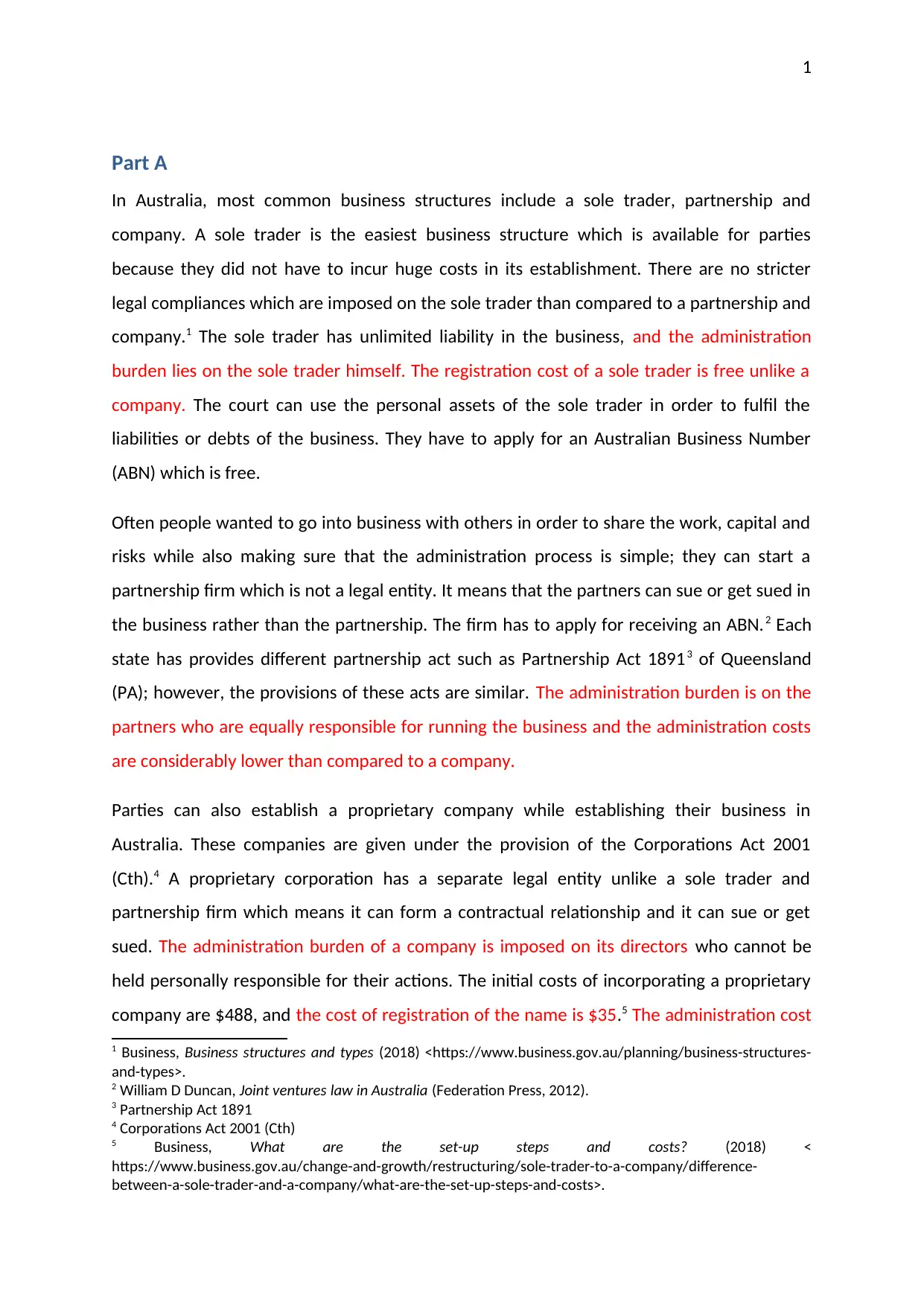
1
Part A
In Australia, most common business structures include a sole trader, partnership and
company. A sole trader is the easiest business structure which is available for parties
because they did not have to incur huge costs in its establishment. There are no stricter
legal compliances which are imposed on the sole trader than compared to a partnership and
company.1 The sole trader has unlimited liability in the business, and the administration
burden lies on the sole trader himself. The registration cost of a sole trader is free unlike a
company. The court can use the personal assets of the sole trader in order to fulfil the
liabilities or debts of the business. They have to apply for an Australian Business Number
(ABN) which is free.
Often people wanted to go into business with others in order to share the work, capital and
risks while also making sure that the administration process is simple; they can start a
partnership firm which is not a legal entity. It means that the partners can sue or get sued in
the business rather than the partnership. The firm has to apply for receiving an ABN.2 Each
state has provides different partnership act such as Partnership Act 18913 of Queensland
(PA); however, the provisions of these acts are similar. The administration burden is on the
partners who are equally responsible for running the business and the administration costs
are considerably lower than compared to a company.
Parties can also establish a proprietary company while establishing their business in
Australia. These companies are given under the provision of the Corporations Act 2001
(Cth).4 A proprietary corporation has a separate legal entity unlike a sole trader and
partnership firm which means it can form a contractual relationship and it can sue or get
sued. The administration burden of a company is imposed on its directors who cannot be
held personally responsible for their actions. The initial costs of incorporating a proprietary
company are $488, and the cost of registration of the name is $35.5 The administration cost
1 Business, Business structures and types (2018) <https://www.business.gov.au/planning/business-structures-
and-types>.
2 William D Duncan, Joint ventures law in Australia (Federation Press, 2012).
3 Partnership Act 1891
4 Corporations Act 2001 (Cth)
5 Business, What are the set-up steps and costs? (2018) <
https://www.business.gov.au/change-and-growth/restructuring/sole-trader-to-a-company/difference-
between-a-sole-trader-and-a-company/what-are-the-set-up-steps-and-costs>.
Part A
In Australia, most common business structures include a sole trader, partnership and
company. A sole trader is the easiest business structure which is available for parties
because they did not have to incur huge costs in its establishment. There are no stricter
legal compliances which are imposed on the sole trader than compared to a partnership and
company.1 The sole trader has unlimited liability in the business, and the administration
burden lies on the sole trader himself. The registration cost of a sole trader is free unlike a
company. The court can use the personal assets of the sole trader in order to fulfil the
liabilities or debts of the business. They have to apply for an Australian Business Number
(ABN) which is free.
Often people wanted to go into business with others in order to share the work, capital and
risks while also making sure that the administration process is simple; they can start a
partnership firm which is not a legal entity. It means that the partners can sue or get sued in
the business rather than the partnership. The firm has to apply for receiving an ABN.2 Each
state has provides different partnership act such as Partnership Act 18913 of Queensland
(PA); however, the provisions of these acts are similar. The administration burden is on the
partners who are equally responsible for running the business and the administration costs
are considerably lower than compared to a company.
Parties can also establish a proprietary company while establishing their business in
Australia. These companies are given under the provision of the Corporations Act 2001
(Cth).4 A proprietary corporation has a separate legal entity unlike a sole trader and
partnership firm which means it can form a contractual relationship and it can sue or get
sued. The administration burden of a company is imposed on its directors who cannot be
held personally responsible for their actions. The initial costs of incorporating a proprietary
company are $488, and the cost of registration of the name is $35.5 The administration cost
1 Business, Business structures and types (2018) <https://www.business.gov.au/planning/business-structures-
and-types>.
2 William D Duncan, Joint ventures law in Australia (Federation Press, 2012).
3 Partnership Act 1891
4 Corporations Act 2001 (Cth)
5 Business, What are the set-up steps and costs? (2018) <
https://www.business.gov.au/change-and-growth/restructuring/sole-trader-to-a-company/difference-
between-a-sole-trader-and-a-company/what-are-the-set-up-steps-and-costs>.

2
of the company is high because of filing of annual review, conducting of meeting and record
keeping which is higher than both sole trader and partnership.
of the company is high because of filing of annual review, conducting of meeting and record
keeping which is higher than both sole trader and partnership.
⊘ This is a preview!⊘
Do you want full access?
Subscribe today to unlock all pages.

Trusted by 1+ million students worldwide
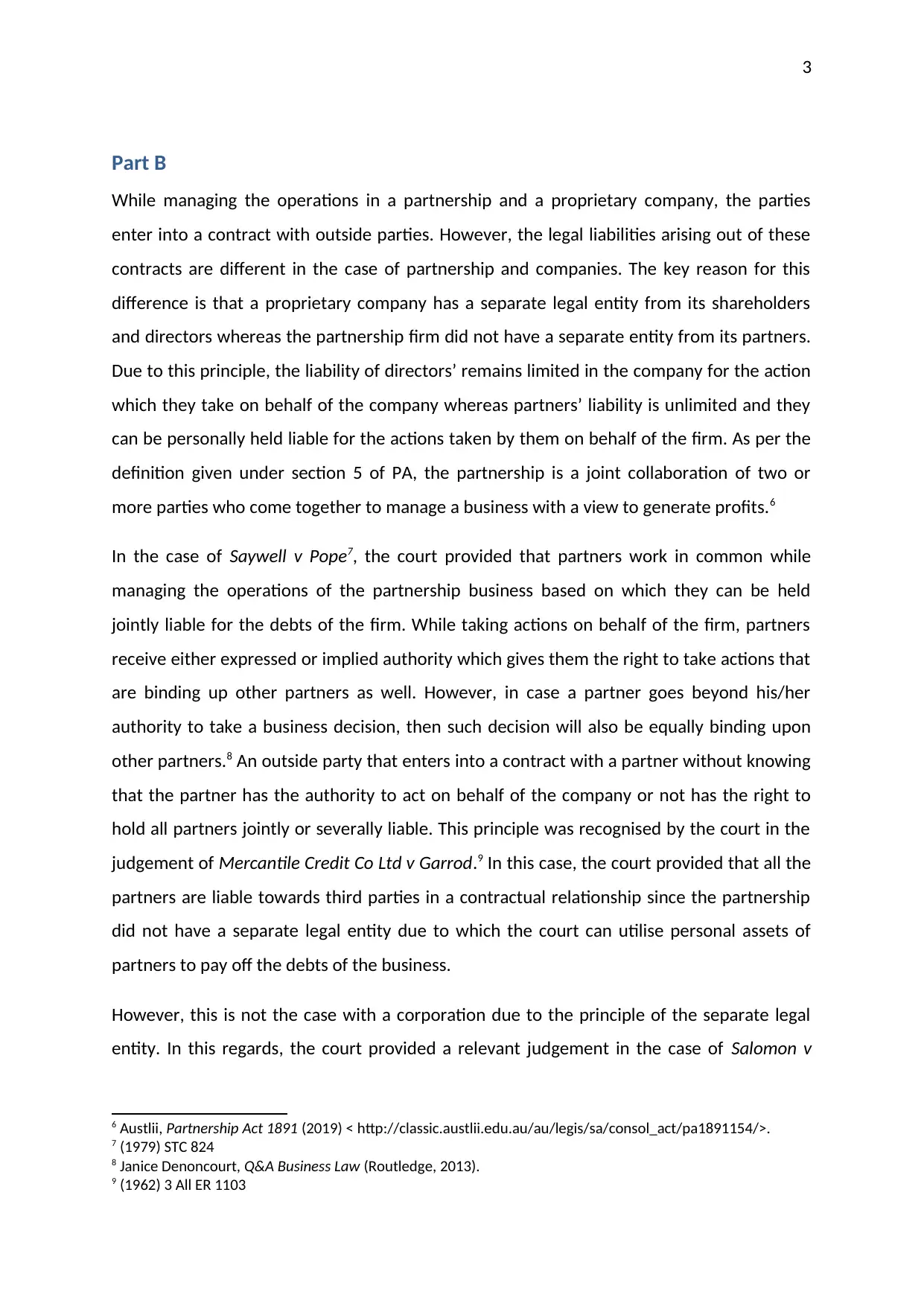
3
Part B
While managing the operations in a partnership and a proprietary company, the parties
enter into a contract with outside parties. However, the legal liabilities arising out of these
contracts are different in the case of partnership and companies. The key reason for this
difference is that a proprietary company has a separate legal entity from its shareholders
and directors whereas the partnership firm did not have a separate entity from its partners.
Due to this principle, the liability of directors’ remains limited in the company for the action
which they take on behalf of the company whereas partners’ liability is unlimited and they
can be personally held liable for the actions taken by them on behalf of the firm. As per the
definition given under section 5 of PA, the partnership is a joint collaboration of two or
more parties who come together to manage a business with a view to generate profits.6
In the case of Saywell v Pope7, the court provided that partners work in common while
managing the operations of the partnership business based on which they can be held
jointly liable for the debts of the firm. While taking actions on behalf of the firm, partners
receive either expressed or implied authority which gives them the right to take actions that
are binding up other partners as well. However, in case a partner goes beyond his/her
authority to take a business decision, then such decision will also be equally binding upon
other partners.8 An outside party that enters into a contract with a partner without knowing
that the partner has the authority to act on behalf of the company or not has the right to
hold all partners jointly or severally liable. This principle was recognised by the court in the
judgement of Mercantile Credit Co Ltd v Garrod.9 In this case, the court provided that all the
partners are liable towards third parties in a contractual relationship since the partnership
did not have a separate legal entity due to which the court can utilise personal assets of
partners to pay off the debts of the business.
However, this is not the case with a corporation due to the principle of the separate legal
entity. In this regards, the court provided a relevant judgement in the case of Salomon v
6 Austlii, Partnership Act 1891 (2019) < http://classic.austlii.edu.au/au/legis/sa/consol_act/pa1891154/>.
7 (1979) STC 824
8 Janice Denoncourt, Q&A Business Law (Routledge, 2013).
9 (1962) 3 All ER 1103
Part B
While managing the operations in a partnership and a proprietary company, the parties
enter into a contract with outside parties. However, the legal liabilities arising out of these
contracts are different in the case of partnership and companies. The key reason for this
difference is that a proprietary company has a separate legal entity from its shareholders
and directors whereas the partnership firm did not have a separate entity from its partners.
Due to this principle, the liability of directors’ remains limited in the company for the action
which they take on behalf of the company whereas partners’ liability is unlimited and they
can be personally held liable for the actions taken by them on behalf of the firm. As per the
definition given under section 5 of PA, the partnership is a joint collaboration of two or
more parties who come together to manage a business with a view to generate profits.6
In the case of Saywell v Pope7, the court provided that partners work in common while
managing the operations of the partnership business based on which they can be held
jointly liable for the debts of the firm. While taking actions on behalf of the firm, partners
receive either expressed or implied authority which gives them the right to take actions that
are binding up other partners as well. However, in case a partner goes beyond his/her
authority to take a business decision, then such decision will also be equally binding upon
other partners.8 An outside party that enters into a contract with a partner without knowing
that the partner has the authority to act on behalf of the company or not has the right to
hold all partners jointly or severally liable. This principle was recognised by the court in the
judgement of Mercantile Credit Co Ltd v Garrod.9 In this case, the court provided that all the
partners are liable towards third parties in a contractual relationship since the partnership
did not have a separate legal entity due to which the court can utilise personal assets of
partners to pay off the debts of the business.
However, this is not the case with a corporation due to the principle of the separate legal
entity. In this regards, the court provided a relevant judgement in the case of Salomon v
6 Austlii, Partnership Act 1891 (2019) < http://classic.austlii.edu.au/au/legis/sa/consol_act/pa1891154/>.
7 (1979) STC 824
8 Janice Denoncourt, Q&A Business Law (Routledge, 2013).
9 (1962) 3 All ER 1103
Paraphrase This Document
Need a fresh take? Get an instant paraphrase of this document with our AI Paraphraser
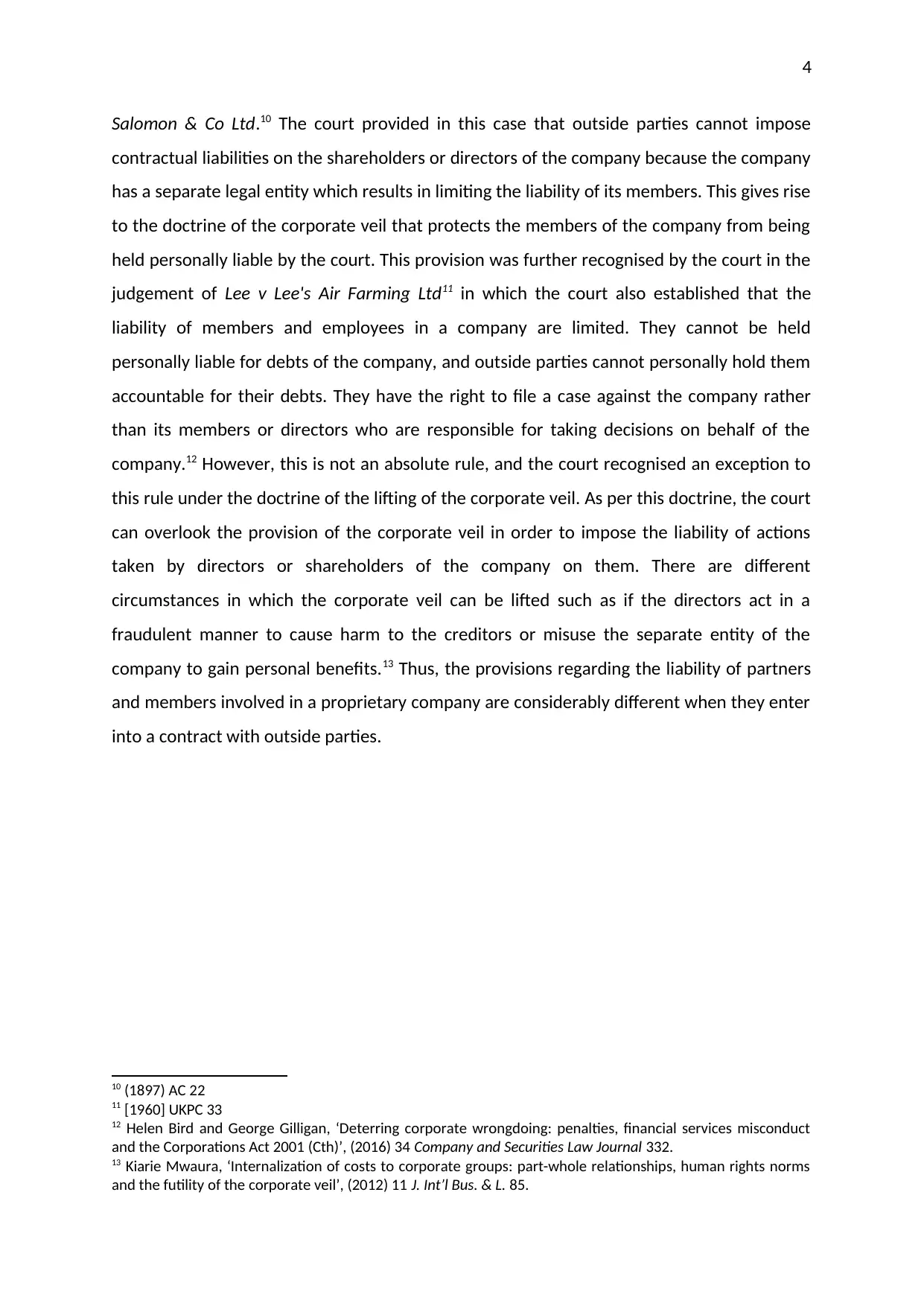
4
Salomon & Co Ltd.10 The court provided in this case that outside parties cannot impose
contractual liabilities on the shareholders or directors of the company because the company
has a separate legal entity which results in limiting the liability of its members. This gives rise
to the doctrine of the corporate veil that protects the members of the company from being
held personally liable by the court. This provision was further recognised by the court in the
judgement of Lee v Lee's Air Farming Ltd11 in which the court also established that the
liability of members and employees in a company are limited. They cannot be held
personally liable for debts of the company, and outside parties cannot personally hold them
accountable for their debts. They have the right to file a case against the company rather
than its members or directors who are responsible for taking decisions on behalf of the
company.12 However, this is not an absolute rule, and the court recognised an exception to
this rule under the doctrine of the lifting of the corporate veil. As per this doctrine, the court
can overlook the provision of the corporate veil in order to impose the liability of actions
taken by directors or shareholders of the company on them. There are different
circumstances in which the corporate veil can be lifted such as if the directors act in a
fraudulent manner to cause harm to the creditors or misuse the separate entity of the
company to gain personal benefits.13 Thus, the provisions regarding the liability of partners
and members involved in a proprietary company are considerably different when they enter
into a contract with outside parties.
10 (1897) AC 22
11 [1960] UKPC 33
12 Helen Bird and George Gilligan, ‘Deterring corporate wrongdoing: penalties, financial services misconduct
and the Corporations Act 2001 (Cth)’, (2016) 34 Company and Securities Law Journal 332.
13 Kiarie Mwaura, ‘Internalization of costs to corporate groups: part-whole relationships, human rights norms
and the futility of the corporate veil’, (2012) 11 J. Int’l Bus. & L. 85.
Salomon & Co Ltd.10 The court provided in this case that outside parties cannot impose
contractual liabilities on the shareholders or directors of the company because the company
has a separate legal entity which results in limiting the liability of its members. This gives rise
to the doctrine of the corporate veil that protects the members of the company from being
held personally liable by the court. This provision was further recognised by the court in the
judgement of Lee v Lee's Air Farming Ltd11 in which the court also established that the
liability of members and employees in a company are limited. They cannot be held
personally liable for debts of the company, and outside parties cannot personally hold them
accountable for their debts. They have the right to file a case against the company rather
than its members or directors who are responsible for taking decisions on behalf of the
company.12 However, this is not an absolute rule, and the court recognised an exception to
this rule under the doctrine of the lifting of the corporate veil. As per this doctrine, the court
can overlook the provision of the corporate veil in order to impose the liability of actions
taken by directors or shareholders of the company on them. There are different
circumstances in which the corporate veil can be lifted such as if the directors act in a
fraudulent manner to cause harm to the creditors or misuse the separate entity of the
company to gain personal benefits.13 Thus, the provisions regarding the liability of partners
and members involved in a proprietary company are considerably different when they enter
into a contract with outside parties.
10 (1897) AC 22
11 [1960] UKPC 33
12 Helen Bird and George Gilligan, ‘Deterring corporate wrongdoing: penalties, financial services misconduct
and the Corporations Act 2001 (Cth)’, (2016) 34 Company and Securities Law Journal 332.
13 Kiarie Mwaura, ‘Internalization of costs to corporate groups: part-whole relationships, human rights norms
and the futility of the corporate veil’, (2012) 11 J. Int’l Bus. & L. 85.
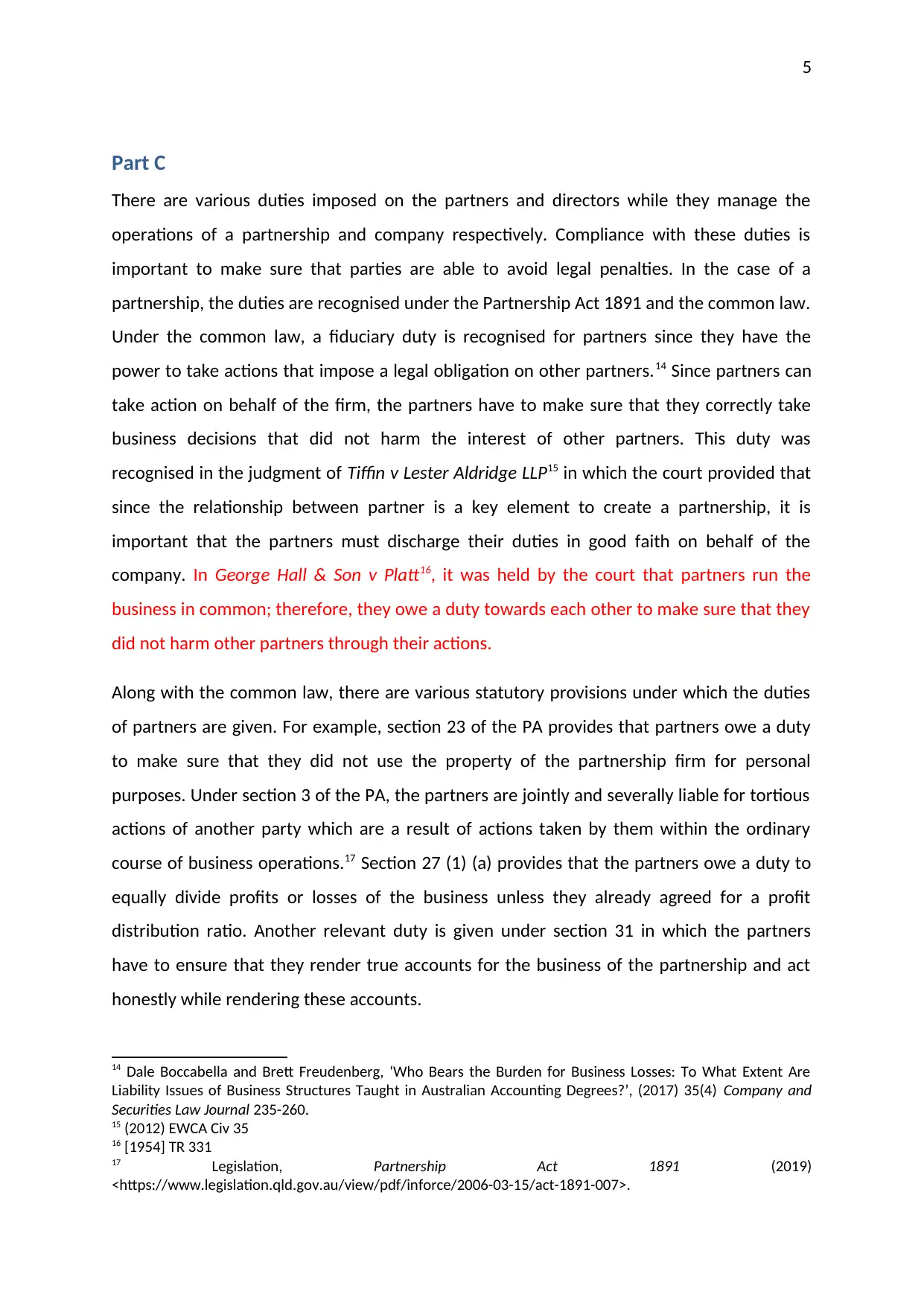
5
Part C
There are various duties imposed on the partners and directors while they manage the
operations of a partnership and company respectively. Compliance with these duties is
important to make sure that parties are able to avoid legal penalties. In the case of a
partnership, the duties are recognised under the Partnership Act 1891 and the common law.
Under the common law, a fiduciary duty is recognised for partners since they have the
power to take actions that impose a legal obligation on other partners.14 Since partners can
take action on behalf of the firm, the partners have to make sure that they correctly take
business decisions that did not harm the interest of other partners. This duty was
recognised in the judgment of Tiffin v Lester Aldridge LLP15 in which the court provided that
since the relationship between partner is a key element to create a partnership, it is
important that the partners must discharge their duties in good faith on behalf of the
company. In George Hall & Son v Platt16, it was held by the court that partners run the
business in common; therefore, they owe a duty towards each other to make sure that they
did not harm other partners through their actions.
Along with the common law, there are various statutory provisions under which the duties
of partners are given. For example, section 23 of the PA provides that partners owe a duty
to make sure that they did not use the property of the partnership firm for personal
purposes. Under section 3 of the PA, the partners are jointly and severally liable for tortious
actions of another party which are a result of actions taken by them within the ordinary
course of business operations.17 Section 27 (1) (a) provides that the partners owe a duty to
equally divide profits or losses of the business unless they already agreed for a profit
distribution ratio. Another relevant duty is given under section 31 in which the partners
have to ensure that they render true accounts for the business of the partnership and act
honestly while rendering these accounts.
14 Dale Boccabella and Brett Freudenberg, ‘Who Bears the Burden for Business Losses: To What Extent Are
Liability Issues of Business Structures Taught in Australian Accounting Degrees?’, (2017) 35(4) Company and
Securities Law Journal 235-260.
15 (2012) EWCA Civ 35
16 [1954] TR 331
17 Legislation, Partnership Act 1891 (2019)
<https://www.legislation.qld.gov.au/view/pdf/inforce/2006-03-15/act-1891-007>.
Part C
There are various duties imposed on the partners and directors while they manage the
operations of a partnership and company respectively. Compliance with these duties is
important to make sure that parties are able to avoid legal penalties. In the case of a
partnership, the duties are recognised under the Partnership Act 1891 and the common law.
Under the common law, a fiduciary duty is recognised for partners since they have the
power to take actions that impose a legal obligation on other partners.14 Since partners can
take action on behalf of the firm, the partners have to make sure that they correctly take
business decisions that did not harm the interest of other partners. This duty was
recognised in the judgment of Tiffin v Lester Aldridge LLP15 in which the court provided that
since the relationship between partner is a key element to create a partnership, it is
important that the partners must discharge their duties in good faith on behalf of the
company. In George Hall & Son v Platt16, it was held by the court that partners run the
business in common; therefore, they owe a duty towards each other to make sure that they
did not harm other partners through their actions.
Along with the common law, there are various statutory provisions under which the duties
of partners are given. For example, section 23 of the PA provides that partners owe a duty
to make sure that they did not use the property of the partnership firm for personal
purposes. Under section 3 of the PA, the partners are jointly and severally liable for tortious
actions of another party which are a result of actions taken by them within the ordinary
course of business operations.17 Section 27 (1) (a) provides that the partners owe a duty to
equally divide profits or losses of the business unless they already agreed for a profit
distribution ratio. Another relevant duty is given under section 31 in which the partners
have to ensure that they render true accounts for the business of the partnership and act
honestly while rendering these accounts.
14 Dale Boccabella and Brett Freudenberg, ‘Who Bears the Burden for Business Losses: To What Extent Are
Liability Issues of Business Structures Taught in Australian Accounting Degrees?’, (2017) 35(4) Company and
Securities Law Journal 235-260.
15 (2012) EWCA Civ 35
16 [1954] TR 331
17 Legislation, Partnership Act 1891 (2019)
<https://www.legislation.qld.gov.au/view/pdf/inforce/2006-03-15/act-1891-007>.
⊘ This is a preview!⊘
Do you want full access?
Subscribe today to unlock all pages.

Trusted by 1+ million students worldwide
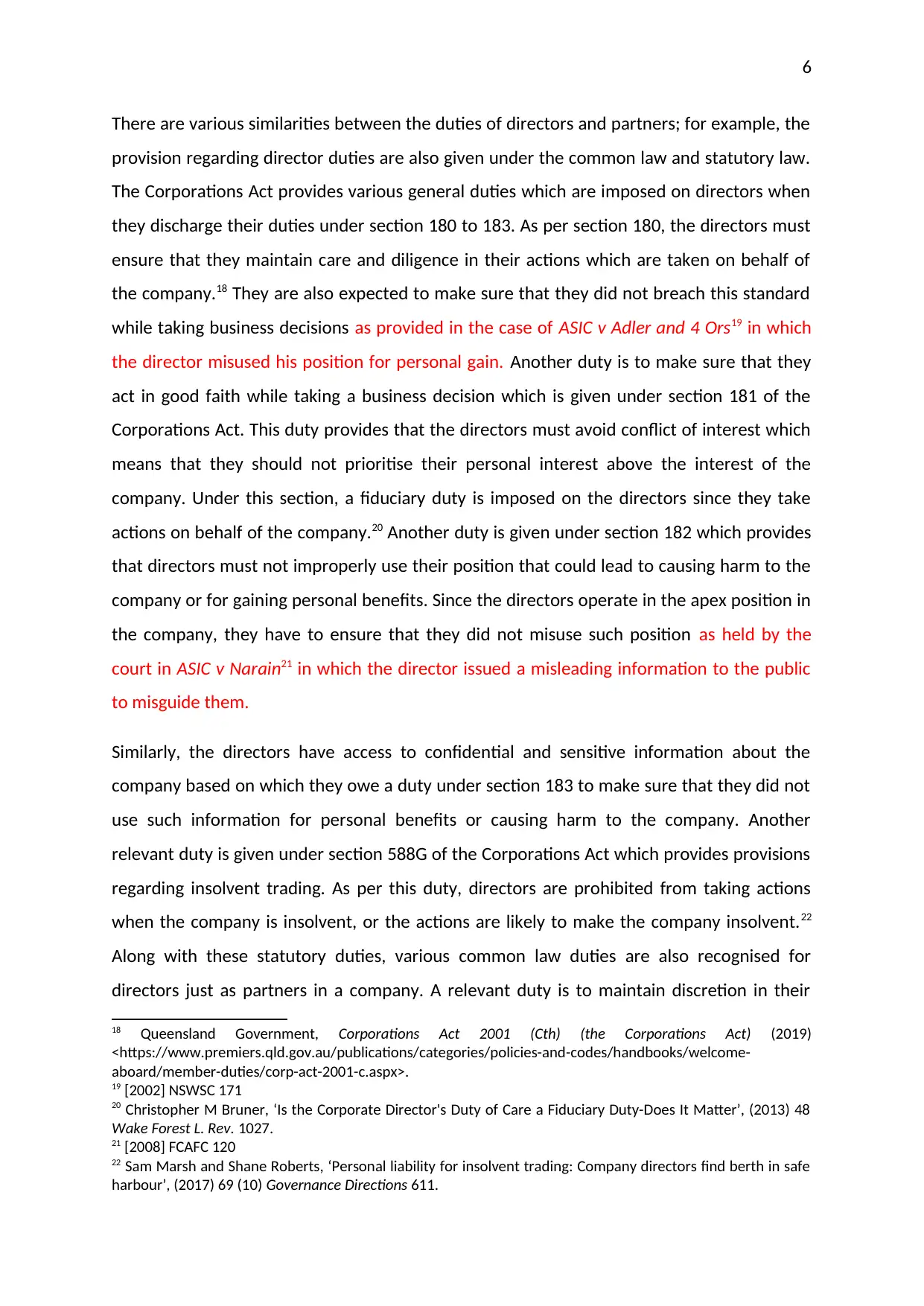
6
There are various similarities between the duties of directors and partners; for example, the
provision regarding director duties are also given under the common law and statutory law.
The Corporations Act provides various general duties which are imposed on directors when
they discharge their duties under section 180 to 183. As per section 180, the directors must
ensure that they maintain care and diligence in their actions which are taken on behalf of
the company.18 They are also expected to make sure that they did not breach this standard
while taking business decisions as provided in the case of ASIC v Adler and 4 Ors19 in which
the director misused his position for personal gain. Another duty is to make sure that they
act in good faith while taking a business decision which is given under section 181 of the
Corporations Act. This duty provides that the directors must avoid conflict of interest which
means that they should not prioritise their personal interest above the interest of the
company. Under this section, a fiduciary duty is imposed on the directors since they take
actions on behalf of the company.20 Another duty is given under section 182 which provides
that directors must not improperly use their position that could lead to causing harm to the
company or for gaining personal benefits. Since the directors operate in the apex position in
the company, they have to ensure that they did not misuse such position as held by the
court in ASIC v Narain21 in which the director issued a misleading information to the public
to misguide them.
Similarly, the directors have access to confidential and sensitive information about the
company based on which they owe a duty under section 183 to make sure that they did not
use such information for personal benefits or causing harm to the company. Another
relevant duty is given under section 588G of the Corporations Act which provides provisions
regarding insolvent trading. As per this duty, directors are prohibited from taking actions
when the company is insolvent, or the actions are likely to make the company insolvent.22
Along with these statutory duties, various common law duties are also recognised for
directors just as partners in a company. A relevant duty is to maintain discretion in their
18 Queensland Government, Corporations Act 2001 (Cth) (the Corporations Act) (2019)
<https://www.premiers.qld.gov.au/publications/categories/policies-and-codes/handbooks/welcome-
aboard/member-duties/corp-act-2001-c.aspx>.
19 [2002] NSWSC 171
20 Christopher M Bruner, ‘Is the Corporate Director's Duty of Care a Fiduciary Duty-Does It Matter’, (2013) 48
Wake Forest L. Rev. 1027.
21 [2008] FCAFC 120
22 Sam Marsh and Shane Roberts, ‘Personal liability for insolvent trading: Company directors find berth in safe
harbour’, (2017) 69 (10) Governance Directions 611.
There are various similarities between the duties of directors and partners; for example, the
provision regarding director duties are also given under the common law and statutory law.
The Corporations Act provides various general duties which are imposed on directors when
they discharge their duties under section 180 to 183. As per section 180, the directors must
ensure that they maintain care and diligence in their actions which are taken on behalf of
the company.18 They are also expected to make sure that they did not breach this standard
while taking business decisions as provided in the case of ASIC v Adler and 4 Ors19 in which
the director misused his position for personal gain. Another duty is to make sure that they
act in good faith while taking a business decision which is given under section 181 of the
Corporations Act. This duty provides that the directors must avoid conflict of interest which
means that they should not prioritise their personal interest above the interest of the
company. Under this section, a fiduciary duty is imposed on the directors since they take
actions on behalf of the company.20 Another duty is given under section 182 which provides
that directors must not improperly use their position that could lead to causing harm to the
company or for gaining personal benefits. Since the directors operate in the apex position in
the company, they have to ensure that they did not misuse such position as held by the
court in ASIC v Narain21 in which the director issued a misleading information to the public
to misguide them.
Similarly, the directors have access to confidential and sensitive information about the
company based on which they owe a duty under section 183 to make sure that they did not
use such information for personal benefits or causing harm to the company. Another
relevant duty is given under section 588G of the Corporations Act which provides provisions
regarding insolvent trading. As per this duty, directors are prohibited from taking actions
when the company is insolvent, or the actions are likely to make the company insolvent.22
Along with these statutory duties, various common law duties are also recognised for
directors just as partners in a company. A relevant duty is to maintain discretion in their
18 Queensland Government, Corporations Act 2001 (Cth) (the Corporations Act) (2019)
<https://www.premiers.qld.gov.au/publications/categories/policies-and-codes/handbooks/welcome-
aboard/member-duties/corp-act-2001-c.aspx>.
19 [2002] NSWSC 171
20 Christopher M Bruner, ‘Is the Corporate Director's Duty of Care a Fiduciary Duty-Does It Matter’, (2013) 48
Wake Forest L. Rev. 1027.
21 [2008] FCAFC 120
22 Sam Marsh and Shane Roberts, ‘Personal liability for insolvent trading: Company directors find berth in safe
harbour’, (2017) 69 (10) Governance Directions 611.
Paraphrase This Document
Need a fresh take? Get an instant paraphrase of this document with our AI Paraphraser

7
work while discharging their duties to make sure that they did not cause harm to the
company or its members based on their actions.23 They are expected to make informed and
independent decisions while act as a director for the company. They are also expected to
perform their duties in a proper manner to make sure that third parties did not question
their management style or business decisions which could seem as conflicting with their
personal interests. Thus, there are various similarities between the duties of partners and
directors.
23 John Lowry, ‘The Irreducible Core of the Duty of Care, Skill and Diligence of Company Directors: Australian
Securities and Investments Commission v Healey’, (2012) 75 (2) The Modern Law Review 249-260.
work while discharging their duties to make sure that they did not cause harm to the
company or its members based on their actions.23 They are expected to make informed and
independent decisions while act as a director for the company. They are also expected to
perform their duties in a proper manner to make sure that third parties did not question
their management style or business decisions which could seem as conflicting with their
personal interests. Thus, there are various similarities between the duties of partners and
directors.
23 John Lowry, ‘The Irreducible Core of the Duty of Care, Skill and Diligence of Company Directors: Australian
Securities and Investments Commission v Healey’, (2012) 75 (2) The Modern Law Review 249-260.
1 out of 8
Related Documents
Your All-in-One AI-Powered Toolkit for Academic Success.
+13062052269
info@desklib.com
Available 24*7 on WhatsApp / Email
![[object Object]](/_next/static/media/star-bottom.7253800d.svg)
Unlock your academic potential
Copyright © 2020–2025 A2Z Services. All Rights Reserved. Developed and managed by ZUCOL.





